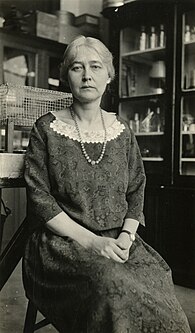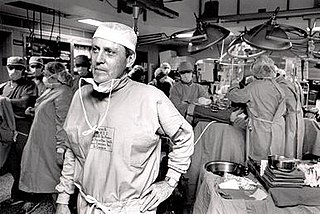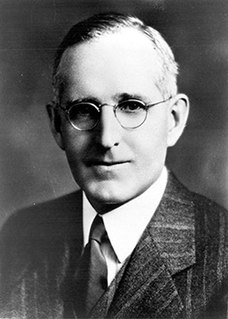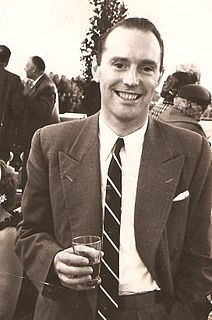
Thomas Alva Edison was an American inventor and businessman who has been described as America's greatest inventor. He developed many devices in fields such as electric power generation, mass communication, sound recording, and motion pictures. These inventions, which include the phonograph, the motion picture camera, and early versions of the electric light bulb, have had a widespread impact on the modern industrialized world. He was one of the first inventors to apply the principles of organized science and teamwork to the process of invention, working with many researchers and employees. He established the first industrial research laboratory.

The Myers–Briggs Type Indicator (MBTI) is an introspective self-report questionnaire indicating differing psychological preferences in how people perceive the world and make decisions. The test attempts to assign four categories: introversion or extraversion, sensing or intuition, thinking or feeling, judging or perceiving. One letter from each category is taken to produce a four-letter test result, like "INFJ" or "ENFP".

Maud Leonora Menten was a Canadian bio-medical and medical researcher who made significant contributions to enzyme kinetics and histochemistry. She is primarily known for her work with Leonor Michaelis on enzyme kinetics and co-authored Michaelis–Menten equation in 1913.

Hilary Koprowski was a Polish virologist and immunologist active in the United States who demonstrated the world's first effective live polio vaccine. He authored or co-authored over 875 scientific papers and co-edited several scientific journals.

Sir John Bertrand Gurdon is an English developmental biologist. He is best known for his pioneering research in nuclear transplantation and cloning. He was awarded the Lasker Award in 2009. In 2012, he and Shinya Yamanaka were awarded the Nobel Prize for Physiology or Medicine for the discovery that mature cells can be converted to stem cells.

The African Blood Brotherhood for African Liberation and Redemption (ABB) was a U.S. black liberation organization established in 1919 in New York City by journalist Cyril Briggs. The group was established as a propaganda organization built on the model of the secret society. The group's socialist orientation caught the attention of the fledgling American communist movement and the ABB soon evolved into a propaganda arm of the Communist Party of America. The group was terminated in the early 1920s.

Thomas Francis Jr. was an American physician, virologist, and epidemiologist. Francis was the first person to isolate influenza virus in the United States, and in 1940 showed that there are other strains of influenza, and took part in the development of influenza vaccines.

Thomas Earl Starzl was an American physician, researcher, and expert on organ transplants. He performed the first human liver transplants, and has often been referred to as "the father of modern transplantation." A documentary, entitled "Burden of Genius," covering the medical and scientific advances spearheaded by Starzl himself, was released to the public in 2017 in a series of screenings.

Lyman James Briggs was an American engineer, physicist and administrator. He was a director of the National Bureau of Standards during the Great Depression and chairman of the Uranium Committee before America entered the Second World War. The Lyman Briggs College at Michigan State University is named in his honor.

The United States Capitol rotunda is the central rotunda of the United States Capitol in Washington, D.C., built 1818–1824. It is located below the Capitol dome, built 1857–1866; the later construction also extended the height of the rotunda walls. It is the tallest part of the Capitol and has been described as its "symbolic and physical heart".
Robert Briggs was a scientist who, in 1952, together with Thomas Joseph King, cloned a frog by nuclear transfer of embryonic cells. The same technique, using somatic cells, was later used to create Dolly the Sheep. Their experiment was the first successful nuclear transplantation performed in metazoans. He was a scientist at the Institute for Cancer Research of the Lankenau Hospital Research Institute when the work was conducted.

Evelyn M. Witkin, born Evelyn Maisel is an American geneticist who was awarded the National Medal of Science for her work on DNA mutagenesis and DNA repair.

Beatrice Mintz is an American embryologist who has contributed to the understanding of genetic modification, cellular differentiation and cancer, particularly melanoma. Mintz was a pioneer of genetic engineering techniques, and was among the first scientists to generate both chimeric and transgenic mammals.

Dr. John Gerald "Gerry" FitzGerald was a Canadian physician and public health specialist who was instrumental in the control of diphtheria, first by producing and freely distributing antitoxin, and then in 1924 by using mass production to enable widespread use of the vaccine devised by Gaston Ramon.

Harry Bolton Seed was an educator, scholar, former Professor at the University of California, Berkeley. He was regarded as the founding father of geotechnical earthquake engineering.
Peter R. Kowey is an American cardiologist and medical researcher.
Grace Medes was an American biochemist, who discovered tyrosinosis—a metabolic disorder today known as tyrosinemia—and studied fatty acid metabolism. She was awarded the Garvan-Olin Medal in 1955 for her work.
Susan K. Gilmour is an American cancer biologist and professor at Lankenau Institute for Medical Research.
Gan-Xin Yan is an American cardiologist, electrophysiologist and cardiovascular research scientist whose studies of arrhythmias have contributed to an understanding of J wave syndromes, long QT syndrome, and other abnormalities that can lead to sudden cardiac death. Yan is a professor at Lankenau Institute for Medical Research (LIMR) and a practicing cardiologist and electrophysiologist at Lankenau Medical Center, both located in Wynnewood, Pennsylvania. He also holds positions as professor of medicine at Sidney Kimmel Medical College of Thomas Jefferson University in Philadelphia and Xi'an Jiaotong University in Xi'an, Shaanxi, China.

Scott K. Dessain is an American oncologist, research scientist, who is a professor at Lankenau Institute for Medical Research and an attending medical oncologist at Lankenau Medical Center, both in Wynnewood, Pennsylvania. He also is co-founder and chief technology officer of Immunome, Inc., a biotechnology company in Philadelphia specializing in development of native human cancer antibodies targeted against cancer antigens. Dessain developed a technology that caused cells to glow, which had been licensed for use by others.














